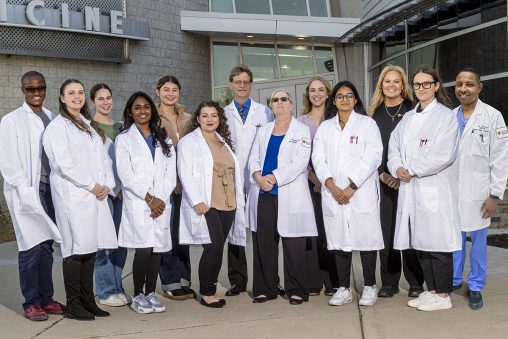
A collaboration between Wright State’s departments of Neuroscience, Cell Biology and Physiology and Obstetrics and Gynecology connects scientific research and clinical practice with patients. (Photo by Erin Pence)
Members of two Wright State University departments met outside White Hall earlier this fall for a group photo and as a show of force. Their combined efforts aim to find ways to identify and treat a life-threatening condition that can kill pregnant mothers and their babies.
The Department of Neuroscience, Cell Biology and Physiology in the College of Science and Mathematics and the Boonshoft School of Medicine and the Department of Obstetrics and Gynecology in the Boonshoft School of Medicine have established a collaboration to connect scientific research and clinical practice with patients at Miami Valley Hospital.
“The point is to highlight the translation collaboration — the bridge — between the basic research we do in the lab and how that translates into patient care,” said Thomas Brown, Ph.D., professor of neuroscience, cell biology and physiology, professor of obstetrics and gynecology, and vice chair for research in the Department of Neuroscience, Cell Biology and Physiology.
The two departments collaborate on pregnancy-related disorders, including preeclampsia, preterm birth and fetal growth. Preeclampsia develops in the placenta during pregnancy and can lead to a sudden and life-threatening increase in the mother’s blood pressure, putting her and her baby at serious risk.
“Preeclampsia and preterm birth are the two leading causes of death and long-term problems in mothers and infants,” Brown said.
Researchers in the lab create models to mimic what happens when an expectant mother develops preeclampsia.
“It makes sense that we’re partnering,” said David Dhanraj, M.D., associate professor and chair of obstetrics and gynecology in the Boonshoft School of Medicine. “Dr. Brown’s got the animal models and he needs to confirm what we’re finding in humans. Working with him is an opportunity for patients who are willing to give a blood sample and have their placentas studied to contribute to this groundbreaking work.”
“We don’t understand this disease even after all these centuries,” Dhanraj said, adding that Hippocrates, known as the father of medicine, noted the condition 2,400 years ago. “Dr. Brown works at the cellular level. To determine if he’s on the right track, he needs to work with someone like myself who can connect with patients and provide input on the clinical implications of the work.”
This translational collaboration between scientific research and the clinic can accelerate the progress toward understanding these pregnancy threats.
“The two groups together form a powerful force,” Brown said.
Dhanraj said the goal is not only to better understand preeclampsia but also to better detect and treat it.
“Preeclampsia is a high driver of infant mortality, too. If we can prevent it, more babies will survive,” he said.
Brown said the collaboration is “representative of highly active laboratories in major institutions. This highlights the outstanding research being done here at Wright State.”
Dhanraj added, “We have a lot of students who are interested in the work that we’re doing. It’s important to know there’s a high level of research on such an important topic that’s happening right here.”
“Research is important. That’s how discoveries are made,” Brown said. “Research drives advances in treatment and patient care leading to solutions for real-world problems, while providing valuable learning experiences and preparing students by enhancing their future careers. In doing so, this elevates the university’s reputation and standing within society and positively impacts the communities it serves.”

 Milling around
Milling around  Wright State recognizes Nursing Professor Kim Ringo for advancing international student success
Wright State recognizes Nursing Professor Kim Ringo for advancing international student success  Wright State honors graduating students for distinguished doctoral dissertations
Wright State honors graduating students for distinguished doctoral dissertations  Top 10 Newsroom videos of 2025
Top 10 Newsroom videos of 2025  Museum-quality replica of historic Hawthorn Hill donated to Wright State
Museum-quality replica of historic Hawthorn Hill donated to Wright State 